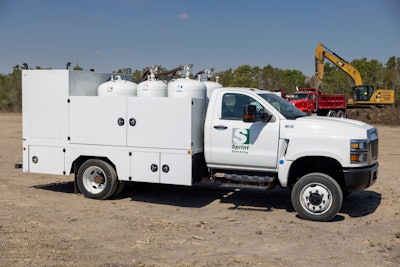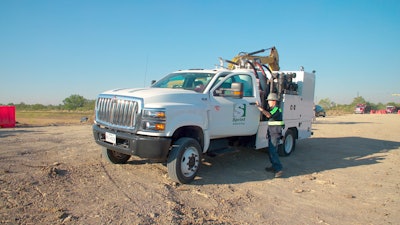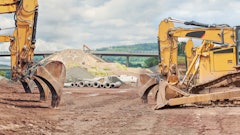The long-standing driver shortage continues to worsen while many contractors also face ever more crowded urban jobsites. These challenges place a squeeze on existing mobile lube activities.
Large Class 7 or Class 8 lube/fuel trucks have been the norm on jobsites around the U.S. for decades. These trucks help technicians maximize preventive maintenance efficiency by transporting large quantities of off-road diesel and oil. Technicians can service multiple machines in the field before returning to the shop for additional fluids.
The capacity of these trucks depends on the gross vehicle weight rating (GVWR), which defines the maximum legal weight of a vehicle including passengers and cargo. The GVWR helps determine how many gallons of fluid a lube truck can transport. It’s not uncommon for Class 7 or Class 8 lube/fuel trucks to haul up to 1,000 gallons of fuel and 400 gallons of maintenance fluids in one trip.
 Smaller, non-CDL trucks weren’t frequently seen on jobsites just a few years agoSage Oil Vac
Smaller, non-CDL trucks weren’t frequently seen on jobsites just a few years agoSage Oil Vac
Cope With the Driver Shortage
The first factor driving the transition to non-CDL trucks is the worsening driver shortage. Despite growing demand for all types of commercial transportation that requires a CDL—namely over-the-road trucking—the number of licensed commercial drivers in the U.S. has not increased. In short, the demand is growing but the qualified labor pool is not. There’s just a shortage of qualified, skilled drivers. It’s as simple as that.
This places lube truck owners in direct competition with over-the-road haulers and local businesses. A contractor or lube truck provider can invest more than a month sending an employee to a driver school to earn a CDL, but there is no guarantee that they can retain that driver to recoup the investment.
Sprint Sand and Clay specializes in dirt work and selling construction materials to contractors and home builders in Greater Houston, Texas. When it comes to operating lube trucks for preventive maintenance, finding drivers with a CDL can demand higher compensation. It is also difficult to compete for available drivers because many don’t want to service equipment. They simply want to drive.
 If the smaller truck has the capacity to tackle a full day of preventive maintenance without returning to the shop, it may provide a lower cost of operation.Sage Oil Vac
If the smaller truck has the capacity to tackle a full day of preventive maintenance without returning to the shop, it may provide a lower cost of operation.Sage Oil Vac
Lube truck owners can proactively address this challenge by eliminating the licensing requirement and creating new opportunities for existing employees. Without the requirement for special licensing, almost any technician in the shop can be assigned to run a non-CDL truck. This opens the door to more hiring opportunities for company owners and managers and more employment opportunities for operators.
Balance Capacity & Efficiency
The second factor in the transition to non-CDL trucks is the actual fluid capacity needed to service equipment. Contractors simply may not need the capacity or fuel-handling capability of a Class 7 or Class 8 lube truck. While not having enough capacity to service all the equipment on the jobsite leads to a loss of efficiency, hauling excess capacity decreases efficiency as well.
 When the maintenance staff must service more than 200 pieces of heavy equipment on 35 jobsites across the fourth largest U.S. city, efficiency is essential.Sage Oil Vac
When the maintenance staff must service more than 200 pieces of heavy equipment on 35 jobsites across the fourth largest U.S. city, efficiency is essential.Sage Oil Vac
“It’s important that the truck has enough storage and fluid capacity to service many pieces of equipment on that side of town before going back and refilling the truck,” said Kyle Cain, president of Sprint Sand and Clay.
Sprint Sand and Clay's service technician typically performs preventive maintenance on every piece of equipment while the truck is on a jobsite to maximize efficiency.
“In today’s world, you have to be as efficient as possible. We attribute our success a lot to equipment that we use and the innovation that’s provided with that equipment, from our dump trucks to our equipment to our lube trucks,” said Cain.
Sprint Sand and Clay turned to a non-CDL open lube body truck. The non-CDL bodies are perfect for heavy equipment preventive maintenance, featuring a 180-gallon (681.37-liter) used oil tank and five fresh product tanks that can be configured for any fluids.
“We really believe in the small compact size of [this] lube truck. It’s very efficient and the cost of ownership compared to having a larger CDL truck with a CDL driver just makes sense,” said Cain.
Despite its compact size, the non-CDL open lube body is up to the task of servicing Sprint Sand and Clay’s 200-machine fleet. It offers the capacity to service all the equipment on up to two jobsites without having to return to refill.
Minimize Operating Costs
The third factor in the transition to a non-CDL lube truck is lower operating costs. It is easy to assume a bigger lube truck would drive efficiency, but that’s not always the case. Traditional Class 7 or Class 8 trucks have high fluid capacities, enabling them to service a lot of equipment. However, because of their size, they are also less fuel efficient when traveling long distances.
If the smaller truck has the capacity to tackle a full day of preventive maintenance without returning to the shop, it may provide a lower cost of operation. For instance, smaller displacement engines consume less fuel when driving long distances between jobsites.
Without wasted extra capacity, usage costs can decrease. Lower upfront costs paired with a smaller operating cost translate into a higher return on investment. Maintenance staff can calculate the total weight of the products that need to be carried to help assess truck size. It’s not always beneficial to automatically size up the next truck.
There are also regulatory costs to consider when operating larger trucks—which become an even bigger issue when traveling across state lines. Multiple non-CDL trucks will sometimes be more cost-effective and efficient than one Class 8 truck. Getting people to make a change like that is sometimes hard, but when pencil is put to paper, these changes can pay for themselves in months.
Access Tight Jobsites
A fourth factor to consider in the transition to a non-CDL lube truck would be jobsite access. Larger tandem-axle trucks can be difficult to maneuver on jobsites, especially those with uneven terrain. A single-axle non-CDL service truck offers enhanced maneuverability on tight or crowded jobsites. These lighter-weight trucks can also perform better than larger tandem-axle trucks in rough terrain. The lube truck provider uses Chevrolet 6500, Ford F-600 and International 6500 four-wheel drive chassis. This adds mobility that a larger truck cannot perform because of its driven steer axle.
 Larger tandem-axle trucks can be difficult to maneuver on jobsites, especially those with uneven terrain. A single-axle non-CDL service truck offers enhanced maneuverability on tight or crowded jobsites.Sage Oil Vac
Larger tandem-axle trucks can be difficult to maneuver on jobsites, especially those with uneven terrain. A single-axle non-CDL service truck offers enhanced maneuverability on tight or crowded jobsites.Sage Oil Vac
“It’s been very easy to maneuver in traffic, especially in Houston,” noted Cain.
Maneuverability coupled with quick connect fillings and the design of the lube truck provider’s system with sealed tanks reduces the chance of oil spills.
“A lot of our jobs are on government entity property—cities and counties—so being able to get in and out without having any spillage or environmental issues is very important to us,” said Cain.
Consider All Alternatives
There are several reasons for transitioning to a non-CDL lube truck. It opens the available labor force. It can reduce operating costs. It is more maneuverable, and there is a lower acquisition cost. The latter was particularly important for Sprint Sand and Clay.
The compact size and efficient operation of the non-CDL truck gives Sprint Sand and Clay a cost-effective heavy equipment service option. It provided a more cost-effective solution than relying on the local equipment dealer for preventive maintenance.
“I think when you compare what we would have to pay from the dealership versus doing it ourselves, it just really made sense for us,” said Cain.
But the non-CDL truck is not the best answer for every application. You need to look at all available options and determine if a larger lube/fuel truck, a trailer or a jobsite skid will work best in your specific application. Each solution has its own unique set of benefits.





























